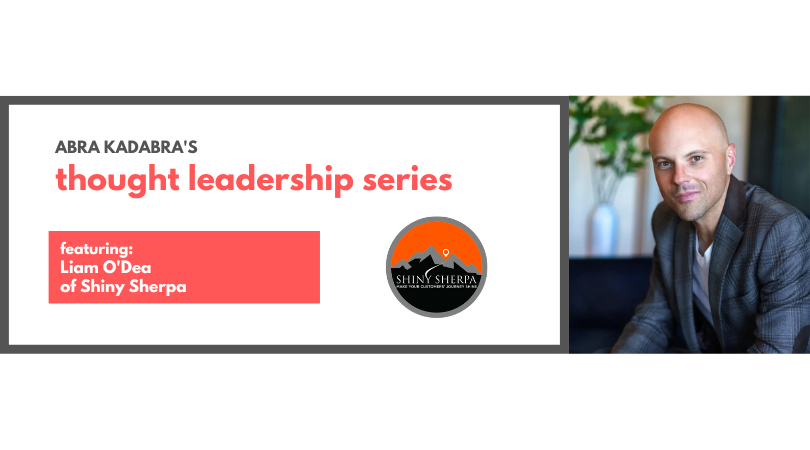For many business owners, sitting down in front of the computer and composing an email to a prospective customer is enough to make them break out in a cold sweat. They don’t know what to say, how to say it or if they should even be saying anything at all.
That’s where Liam O’Dea comes in.
O’Dea is the founder of Minneapolis-based Shiny Sherpa, a self-service email library for home services business owners that’s designed to help turn prospects into buyers. Shiny Sherpa users simply log into their accounts, find expertly written email templates that are fun, friendly and informative, select and download the ones they want to use and send them out through their CRM or email system. Whether they’re looking for follow-up messaging, content for nurture campaigns or anything in between, it’s O’Dea’s goal to help business owners give their customers a shiny journey by providing them with the tools they need to communicate effectively and proactively.
“It’s all about engaging with prospective buyers, building a relationship with them and then selling to them, but not in that stereotypical ‘used car salesman’ type of way,” he said. “I try to make all the messaging as conversational as possible.”
Aside from talking with home services business owners to learn more about the industry and using that information to write copy for the growing Shiny Sherpa library, O’Dea spends a lot of his time educating people on the value of email marketing.
 “The average return globally on $1 spent doing email marketing is $42, so that’s 4,200 percent,” O’Dea said. “With a lot of these home services businesses, emails are the low-hanging fruit and if they’re not sending them, they’re leaving money on the table.”
“The average return globally on $1 spent doing email marketing is $42, so that’s 4,200 percent,” O’Dea said. “With a lot of these home services businesses, emails are the low-hanging fruit and if they’re not sending them, they’re leaving money on the table.”
Finally, O’Dea also helps business owners understand that despite what they may believe, email marketing doesn’t bother anyone. In fact, he said, it’s quite the opposite.
“I would argue that you actually have a responsibility to follow up with someone who has already reached out to you first,” he said. “And even if they’re not reading the emails you send them, they’re at least seeing your name and becoming familiar with your company. It’s not like you’re knocking on their door and taking up their time.”
Now that you know why email marketing is important, how exactly do you go about creating messages that get results? What are the dos and don’ts? And what else should you know before you hit send? Here are a few of O’Dea’s tips and suggestions:
- Write a powerful subject line: You could compose the greatest email in the history of all time but if you don’t grab the reader’s attention with your subject line, you might as well be sending them a blank document. According to O’Dea, the best subject lines incorporate curiosity, benefit and proof. Emails that have interesting subject lines and pique the reader’s curiosity or promote a benefit such as a discount can definitely encourage people to open your message. Additionally, a subject line with an impressive statistic or testimonial about your company can provide the proof the reader needs to check out the rest of your email. “Getting two out of the three elements into the subject line is ideal,” O’Dea said. “Getting all three is going to be difficult without having a giant subject line that gets cut off and that kind of defeats the purpose of what you’re trying to accomplish.”
- Hook them with your first sentence: Just like the subject line, the first sentence of your email should be strong enough that it makes the recipient want to keep on reading. “One thing I really like to do is treat it like we’re in the middle of a conversation, like I’m picking up where we ‘left off,’” O’Dea said. “You want to make the message conversational, you want to make it about the reader and you want to make it easy for them to see how your product or service can benefit them.”
- Make it clear what you want the reader to do next: Now that you’ve written an awesome email that flows naturally, is grammatically correct and provides valuable and accurate information, it’s time to execute the grand finale – the call to action. And it’s important to know exactly what you want your recipients to do once they finish reading. Should they click a link and complete a form? Reply directly to your message? Give you a call or shoot you a text? Your goal is to be clear and direct with your call to action so your readers won’t be confused about how to proceed.
Now, here are a few dos and don’ts:
- Do take the time to dig deeper into your company: It can be difficult to write good messaging if you don’t really understand your business’s mission, vision and values. Before you start drafting your emails, spend some time thinking about your company’s strengths. What do you do better than anyone else? Why do your customers love doing business with you? Is there something from a branding perspective that you can incorporate into your messaging to make it more fun and engaging? Once you do a little brainstorming and gain a more holistic picture of your company, you’ll likely find it much easier to write effective and informative emails.
- Don’t feel like you have to be creative: Contrary to popular belief, you don’t have to be gifted at creative writing to write a good email. “I actually think that’s a false barrier to put up,” O’Dea said. “Look at it this way. If you can think strategically and analytically about your business and what kind of journey you want to give a prospect so they come and buy from you, that’s what’s really important. It’s not about creativity – it’s about connecting with the reader to take some kind of action.”
- Do follow up after the initial email: These days, everyone’s inboxes are overflowing with messages they meant to respond to but got too busy. Therefore, it’s perfectly OK to send a few follow-up messages. Who knows? Your second, fourth or even sixth or email might land in front of them at the perfect time. “It’s really not an annoyance,” O’Dea said. “If it’s something they don’t want to read, they can just ignore it.”
- Don’t walk on eggshells: O’Dea has reviewed a number of client emails that sound something like this: “Hi Joe, Thanks so much for getting a quote from us. I really don’t want to be a bother but I just wanted to follow up, see how you’re doing and find out if there’s anything I can do for you.” It’s a perfectly friendly message, but the sender isn’t taking ownership of why he’s sending it because he’s overly concerned he might annoy someone. Instead of taking that type of timid, apologetic tone with your emails, come from a place of strength, especially if you’re writing to a warm lead. Let them know that you want to work with them, then give them some information about why they should do business with you and how your services will benefit them. “Think about it like this,” O’Dea said. “You wouldn’t want to listen to a salesperson who is in your face being manipulative and obnoxious, but you also don’t want someone who’s got their tail between their legs. Don’t be afraid to own the space you’re in.”
- Don’t shy away from writing a long email: Most people assume that no one will read a long message. While that can be true, if you write a good email that has lots of valuable information, plenty of readers will stick with it until the end.
- Do reach out for help if you need it: If you don’t want to add email writing to your already full plate, it’s perfectly fine to outsource it. Whether it’s asking a friend or family member to help you or reaching out to O’Dea and Shiny Sherpa, it’s all about doing what works best for you.
Abra Kadabra Environmental Services is proud to share the wisdom of business owners from our community through our thought leadership series. If you’d like to be featured, click here.







